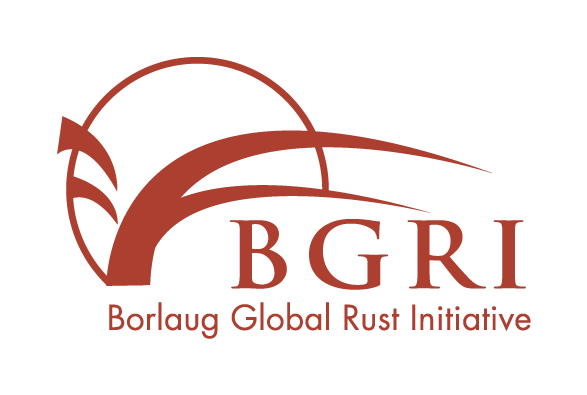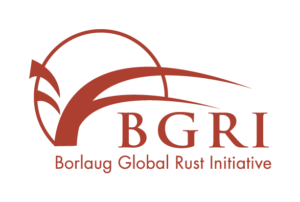April 14-17, 2018
The 2018 BGRI Technical Workshop featured over 400 participants from 51 countries coming together in Morocco, hosted by ICARDA.
The BGRI was proud to present the Norman Borlaug statue for lifetime achievements in wheat research to Dr. Mahmoud El-Solh, former director of ICARDA. Dr. El-Solh’s leadership during war time ensured that generations of accumulated research, knowledge, and precious seed samples were preserved.
Into the technical presentations, Mogens Hovmoller showed how recent intercontinental spreads of yellow rust are causing new epidemics, with big problems in North and East Africa, and South America, amongst others. New races of stem rust have also been emerging. Whereas the focus used to be on Ug99 or Digalu, this changed around 2013 and stem rust populations are now very diverse, it’s even possible to detect 8 or 9 races in a sample from a single field. New virulence is also emerging, and several races are causing big problems across many regions worldwide. In Siberia, for example, there has been a gradual increase of stem rust incidence in the last 5-7 years and 90% of varieties grown there are highly susceptible.
BGRI 2018 Technical Workshop playlist
On April 15, Dhouha Kthiri warned us that the emergence of new leaf rust races is causing problems for durum production in the Canadian prairies. This is particularly important given Canada’s role as the world’s leading producer and exporter of durum wheat. Dhouha highlighted that there are fewer resistance genes identified in durum wheat than in bread wheat, and that virulence to one of the most popular Lr resistance genes has been detected, so she is using KASP markers to genotype F8 recombinant inbred lines and develop linkage maps for Lr genes. Marco Maccaferri also talked about the work of his team on durum wheat, and how, in collaboration with Kansas State University, he has successfully developed the Svevo-Whole-Genome Radiation Hybrid panel, the first of its kind. Meanwhile Sisay Alemu and his team aimed to identify new sources of yellow rust resistance for durum wheat in Ethiopia. They identified a single significant Yr locus on chromosome 1BS in Ethiopian landraces by phenotyping 300 landraces and released cultivars and conducting SNP data and association analysis.
As Pablo Olivera and Les Szabo highlighted, the emergence of Ug99 catalyzed the development of a solid surveillance system, with many partners working together. But the level of collaboration seems to now extend much further than surveillance. Dhouha talked about how maps were made available to her. And when Clemence Marchal was conducting her work to show that Yr5 and Yr7 are closely linked genes, rather than true alleles, she mentioned that when they needed to clone Yr5, all the hard work had already been done for her by McGrann et al. Meanwhile Lesley Boyd’s presentation reported on a collaboration that has been going on for more than 10 years. One of the great things BGRI has done is to bring people together, both in meetings like this and through its mission to reduce the world’s vulnerability to stem, yellow, and leaf rusts of wheat; facilitate sustainable international partnerships to contain the threat of wheat rusts; and enhance world productivity to withstand global threats to wheat security. However, we need to ensure that these collaborations continue and even expand. When she started working on wheat rust, I’m not sure that Diane Saunders thought her work might be affected by moths. But despite the historic barberry eradication schemes just described by Radhika Bartaula, people in the UK are now beginning to plant barberry to conserve a rare moth, so Diane now also works with conservation organizations as collaborators in protecting cereals from rust. As several of the speakers mentioned, when and the where of the next high-impact race incursions are not known. To mitigate their impact, coordinated surveillance at all levels across cereals and alternative hosts in various regions, compilation of data from many sources is necessary. In addition, there needs to be a ‘common language’ and utilization of shared facilities and resources.
The panel session on “Women speak up: building capacity in the pipeline” invited three female leaders in their field to talk about what got them into plant science and how younger generations should chart their careers. Lesley Boyd, who is Research Programme Leader and Head of NIAB International, told us how she had wanted to be a scientist from a young age, and highlighted the importance of gaining experience at different institutions in different countries. Wafaa El Khoury, from IFAD’s Policy and Technical Advisory Division, emphasized the importance of being proactive and taking advantage of every opportunity, even when there are risks involved. She also reminded us that you have to be passionate about what you’re doing! And this was something clearly evidenced by the third panelist, Silvia German, who served as principal researcher at the National Agricultural Research Institute of Uruguay since 1979 and also won the 2017 Women in triticum mentor award. Their comments and the lively discussion that followed were very informative for me, and I know they were for many early career people in this room, not only the women.
There were overviews from Hans Braun, Ravi Singh, and Alexey Morgunov on breeding for genetic gain, and how the international wheat improvement network enables the wheat community to rapidly respond to new challenges to produce enormous impacts, not only in terms of improved food security and capacity building, but also in terms of the economic benefits, which are estimated at 2.1 to 5.7 billion dollars.
On April 16, it was a great opportunity for us to learn about some of the new approaches being used in wheat breeding. Philomin Juliana asked how we can deliver future genetic gains in wheat – including improvement of grain yield and stem rust resistance – using genomic selection. In a wonderfully honest presentation, Philomin showed us how within-population accuracies for predicting traits were around 0.4, but accuracy dropped to around 0.17 when predicting across populations. If genomic selection is to be successfully applied in wheat breeding programs, we will need to better understand G x E interactions and include traits that affect grain yield, such as lodging, in the models. This links to the work being done by Suchismita Mondal and the team at CIMMYT, who are using high throughput data to investigate lodging and crop height estimations, among other traits, through the use of planes and drones. Thanks to a highly efficient collaboration with Kansas State University, they have been able to reduce the image processing and extraction stage of their phenomics process from around 7 months to 3-4 weeks, meaning that the extracted data is now available by the end of the wheat cycle. As this technology rapidly advances, they are looking at how they can use high-throughput methods in disease assessment. After NDVI measurements were successfully used to assess spot blotch, the team turned their attention to rust and have had some success with stem rust, though leaf and yellow rust have proved trickier. Another new technology looking to reduce the time it takes to get new varieties to farmers is speed breeding. This revolutionary approach can be used to accelerate plants’ development and achieve up to six generations of wheat per year, compared to one or two under traditional or shuttle breeding systems. This duration could be reduced even further if speed breeding is combined with other technologies such as CRISPR. However, it is important to remember that speed breeding required large investments in infrastructure, and there still needs to be further work done to reduce the costs, e.g. by using LED lights to reduce electricity costs.
One of the achievements reported by Lee was the recent release of a high protein milling wheat with tolerance to pre-harvest sprouting. This result is something that should always be considered, no matter how advanced the technology we are using. At the end of the day, it is about getting varieties into farmers’ fields. Zerihun Tadesse highlighted the importance of this in Ethiopia, where demand for wheat is rapidly increasing, but where they have had big problems with recurrent rust epidemics. Through fast track testing and release, accelerated seed multiplication, and scaling-out of technologies, they are working to replace susceptible varieties in farmers’ fields.
This recap is based on the summation provided by Emma Quilligan, April 17, 2018
Abstracts
Awards
WIT Early Career Winners
Mentor Winner
Gene Stewardship





